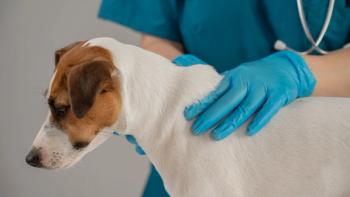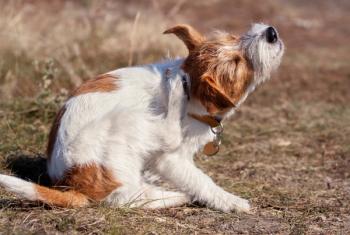
Dermatophytosis (Proceedings)
Three species of fungi are responsible for most cases of dermatophytosis in dogs and cats.
Three species of fungi are responsible for most cases of dermatophytosis in dogs and cats. M. canis is by far the most common, followed by M. gypseum and T. mentagrophytes. Cats are considered the natural hosts of M. canis, while M. gypseum is found in the soil (geophilic), and T. mentagrophytes is harbored by rodents.
Young pets carry an increased risk of developing dermatophytosis, reflecting their immature immune status, potential for exposure to carriers, and perhaps physiological differences. Microsporum canis is the most frequent cause of ringworm in kittens and puppies. Entire litters can develop lesions, typically multifocal alopecic, mildly erythematous patches that progressively develop papules, scale and hyperpigmentation. Frequently affected areas of kittens and puppies include the head, muzzle, pinnae, and distal limbs. Immunosuppressed adult cats and dogs are also at risk of developing generalized infections. Predisposing conditions include FeLV and hyperglucocorticism. These patients are often more refractory to therapy. Yorkshire terrier dogs and Persian cats are also reportedly at increased risk.
M. gypseum infections are often located on the bridge of the canine muzzle, just caudal to the planum nasale, presumably due to exposure while digging in the soil. T. mentagrophytes may cause a generalized folliculitis in dogs that may mimic bacterial folliculitis. In cats, dermatophytosis may mimic feline acne or "miliary" dermatitis. Claw infection with dermatophytes (onychomycosis) is rather uncommon in dogs and cats. T.mentagrophytes in dogs may be associated with significant acantholysis and a clinical presentation similar to pemphigus foliaceus. In cats, T. mentagrophytes has been associated with pruritus, alopecia and scale of the pinnae.
Approximately 50 percent of M. canis infections will result in hair fluorescence with ultraviolet (Wood's) light examination. M. gypseum and T. mentangrophytes do not fluoresce. Microscopic examination of plucked hairs (trichography) provides a rapid method of confirming the diagnosis if ectothrix fungal spores are recognized. When ringworm is suspected, a fungal culture should be performed to confirm the diagnosis and to identify the species of ringworm. If done in house, dermatophyte test media plates should be examined daily for red color change associated with early colony growth. Dermatophyte colonies will vary from white to tan or cinnamon colored. In multiple pet households or catteries, a toothbrush can be used to collect hair for culture of potential asymptomatic dermatophyte carriers.
In general, treatment of pediatric patients should be limited to topical products until they are approximately 16-weeks old. Topical application of a lime-sulfur dip (LimePlus Dip; DermaPet) every five to seven days is suggested. A protective collar should be applied until the patient is dry to prevent excessive ingestion through grooming, and care is taken to ensure that body temperature is maintained after applying a full-body dip to a pediatric patient. Affected animals should be isolated and the patient's environment cleaned with 0.5% bleach, when that is feasible. Pet owners should be educated regarding the zoonotic potential of dermatophytosis.
For pets older than 16 weeks, systemic therapy can be considered, following dosage recommendations for adult dogs and cats. Topical creams and lotions may be appropriate for localized lesions. Topical clotrimazole, miconazole, ketoconazole, or terbinafine may be prescribed for localized lesions. Oral drugs used in dogs and cats for the treatment of dermatophytosis include griseofulvin, fluconazole, itraconazole, ketoconazole, and terbinafine. Treatment is continued until there is both a clinical resolution and a microbiological cure, as determined by follow-up fungal cultures. The required course of therapy is often six to eight weeks, but may be longer in some cases. Monthly monitoring of the pet's serum chemistry panel is prudent.
Newsletter
From exam room tips to practice management insights, get trusted veterinary news delivered straight to your inbox—subscribe to dvm360.





